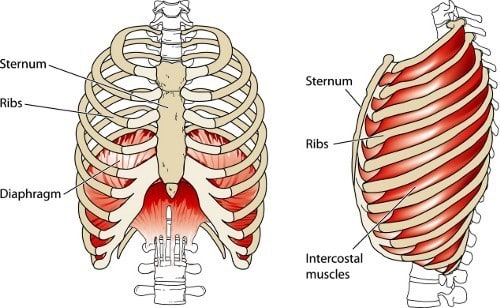The sternum is typically the nucleus of a protective rib cage. It’s large, flat, and runs down the center of the chest, acting as a shield for the internal organs. Though the bone seems like a fairly simple, T-shaped structure, there are three parts to it: manubrium, body, and xiphoid.
It’s connected to the ribs by tough, costal cartilage. A sternum is present in most animals, though snakes, turtles, some insects, and certain lizards lack a breastbone in favor of other protective functions or biological structures.
The Sternum in Mammals

Three major parts make up the sternum: the manubrium, the body, and the xiphoid.
©Sakurra/Shutterstock.com
In humans, the sternum begins at the very bottom of the neck and runs straight down, ending in a hollow at the top, center of the abdomen. With the connecting ribs, it serves as a protective shield over the heart, large portions of the lungs, and other, critical organs within the body.
Manubrium
The manubrium is the largest part of the breastbone, and it’s also the upper part of it. The first pairs of ribs connect to the manubrium. This is where the ribs are smallest and tightly packed in together.
Body
It’s not the largest part of the sternum but it is the longest part. The body extends from the short manubrium down to the tip, with the tip being the xiphoid. Most of the ribs connect to the body portion of the sternum.
Xiphoid
The xiphoid is the smallest part of the sternum and features the aforementioned T-shape to a very small degree. This portion of the sternum is very small but also very dense, covered in layers of vascular tissue.
Animals retain most of the same features. However, in birds, the sternum is more pronounced and shaped for flying. The biggest difference between most mammals and humans is the various lengths of the sternum according to the animal. For obvious reasons, the sternum of a bear is much longer and broader than the sternum of a cat.
Relation to the Diaphragm

The diaphragm is attached to the bottom of the sternum, at the xiphoid.
©Blamb/Shutterstock.com
The sternum is very important as a protective mechanism, shielding the major organs and large blood vessels from injury. However, it’s also necessary for the diaphragm’s ability to operate. The diaphragm is the muscle that allows the lungs to expand and contract, taking in and expelling air.
The diaphragm is attached to the very bottom of the sternum (the xiphoid), along with the lower ribcage and a portion of the spinal cord. As the diaphragm expands, its attachment to these bones allows it to expand outward while simultaneously lifting the lungs.
Without that attachment, it would be much harder to breathe because the diaphragm would be unable to expand the bones outward, allowing the lungs room to expand.
Sternum Pronunciation
Sternum is pronounced: stur – nuhm






